Exploring Communication in Autistic Children: A Research Report
VerifiedAdded on 2021/04/21
|8
|1700
|39
Report
AI Summary
This report outlines a qualitative research study employing a phenomenological approach to investigate the communication and social interaction of autistic children in school and home environments. The research aims to highlight differences in communication patterns between these settings, utilizing semi-structured interviews with children and their mothers, along with visual aids like photographs. A purposive sampling method will be used to recruit 15 children aged 10-12 diagnosed with autism, ensuring English as their first language. Data analysis will involve Interpretative Phenomenological Analysis (IPA), with a reflective journal used to address the interpretive role of the researchers. Ethical considerations, including informed consent and confidentiality, are emphasized. The findings are expected to contribute to a better understanding of the communication challenges faced by autistic children and inform improvements in support systems for enhanced socialization in various settings. The report references multiple sources to support the research methodology and findings.
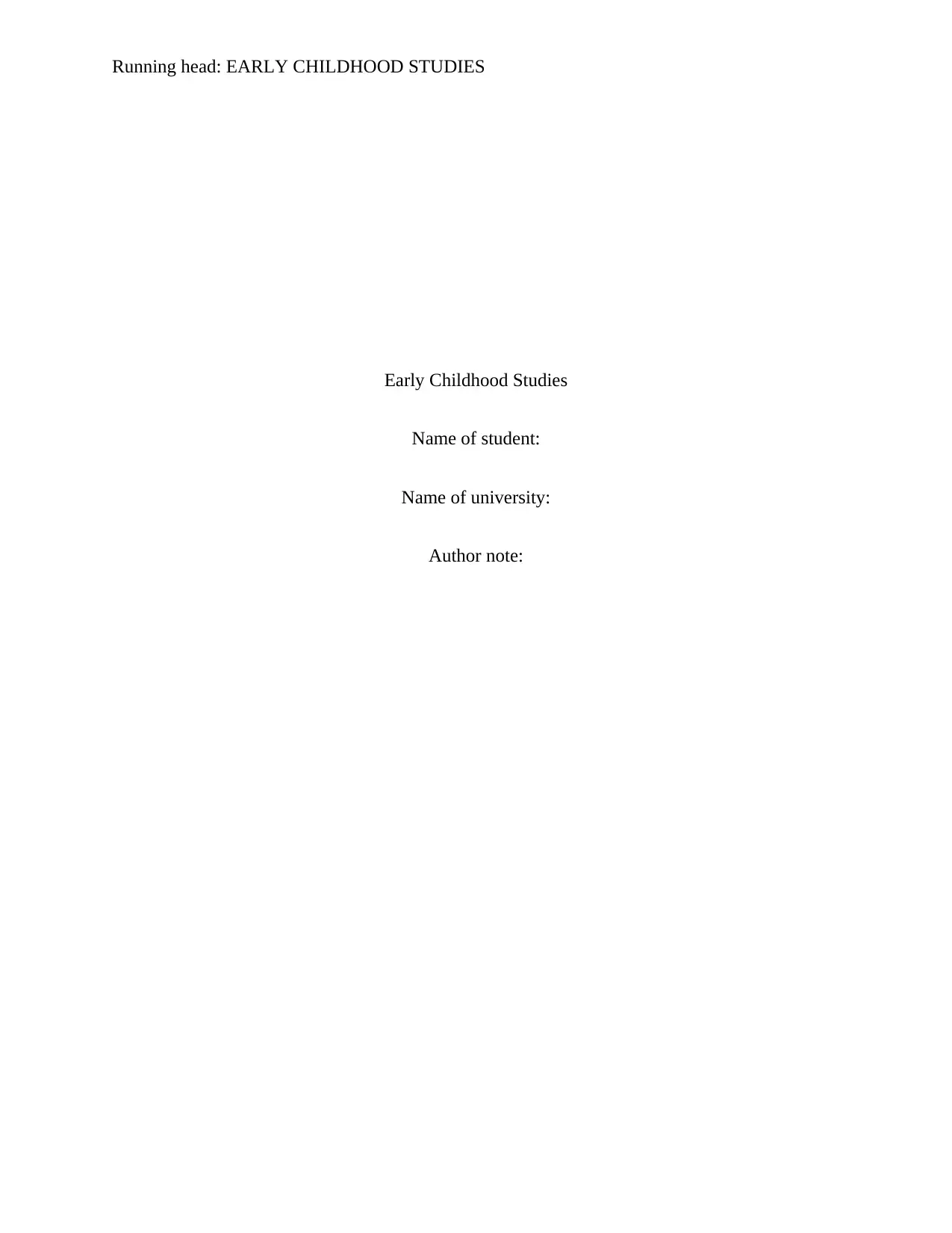
Running head: EARLY CHILDHOOD STUDIES
Early Childhood Studies
Name of student:
Name of university:
Author note:
Early Childhood Studies
Name of student:
Name of university:
Author note:
Paraphrase This Document
Need a fresh take? Get an instant paraphrase of this document with our AI Paraphraser
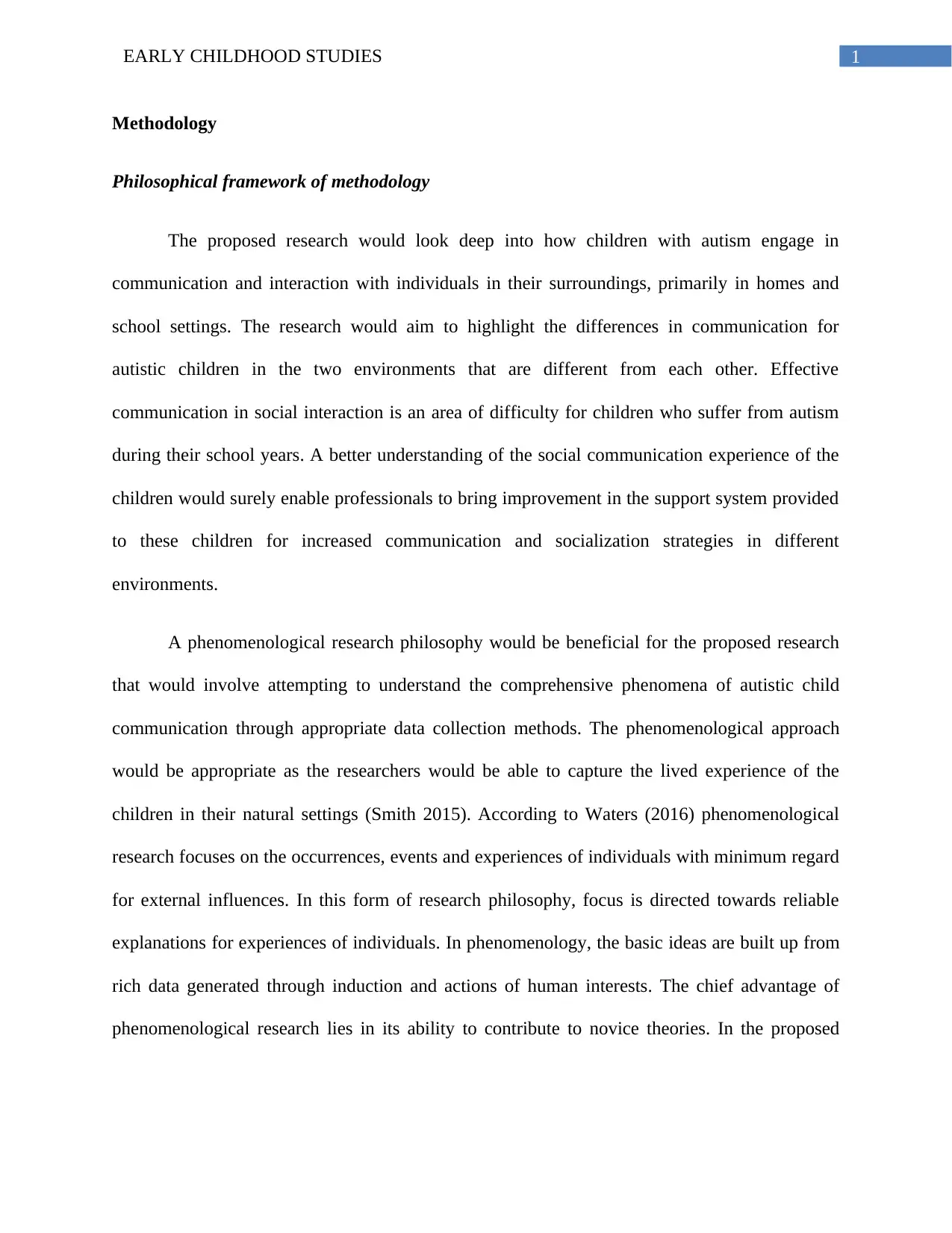
1EARLY CHILDHOOD STUDIES
Methodology
Philosophical framework of methodology
The proposed research would look deep into how children with autism engage in
communication and interaction with individuals in their surroundings, primarily in homes and
school settings. The research would aim to highlight the differences in communication for
autistic children in the two environments that are different from each other. Effective
communication in social interaction is an area of difficulty for children who suffer from autism
during their school years. A better understanding of the social communication experience of the
children would surely enable professionals to bring improvement in the support system provided
to these children for increased communication and socialization strategies in different
environments.
A phenomenological research philosophy would be beneficial for the proposed research
that would involve attempting to understand the comprehensive phenomena of autistic child
communication through appropriate data collection methods. The phenomenological approach
would be appropriate as the researchers would be able to capture the lived experience of the
children in their natural settings (Smith 2015). According to Waters (2016) phenomenological
research focuses on the occurrences, events and experiences of individuals with minimum regard
for external influences. In this form of research philosophy, focus is directed towards reliable
explanations for experiences of individuals. In phenomenology, the basic ideas are built up from
rich data generated through induction and actions of human interests. The chief advantage of
phenomenological research lies in its ability to contribute to novice theories. In the proposed
Methodology
Philosophical framework of methodology
The proposed research would look deep into how children with autism engage in
communication and interaction with individuals in their surroundings, primarily in homes and
school settings. The research would aim to highlight the differences in communication for
autistic children in the two environments that are different from each other. Effective
communication in social interaction is an area of difficulty for children who suffer from autism
during their school years. A better understanding of the social communication experience of the
children would surely enable professionals to bring improvement in the support system provided
to these children for increased communication and socialization strategies in different
environments.
A phenomenological research philosophy would be beneficial for the proposed research
that would involve attempting to understand the comprehensive phenomena of autistic child
communication through appropriate data collection methods. The phenomenological approach
would be appropriate as the researchers would be able to capture the lived experience of the
children in their natural settings (Smith 2015). According to Waters (2016) phenomenological
research focuses on the occurrences, events and experiences of individuals with minimum regard
for external influences. In this form of research philosophy, focus is directed towards reliable
explanations for experiences of individuals. In phenomenology, the basic ideas are built up from
rich data generated through induction and actions of human interests. The chief advantage of
phenomenological research lies in its ability to contribute to novice theories. In the proposed
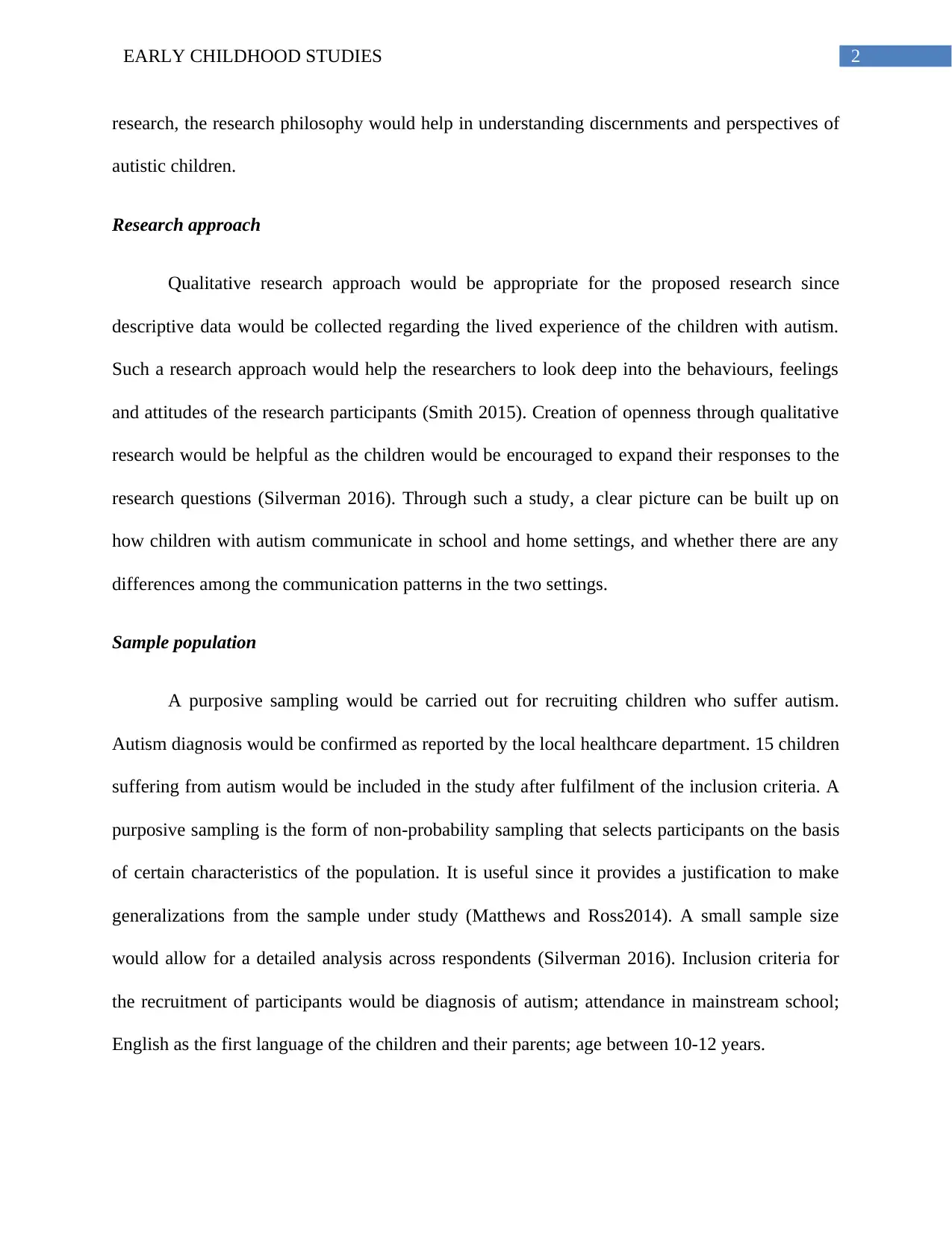
2EARLY CHILDHOOD STUDIES
research, the research philosophy would help in understanding discernments and perspectives of
autistic children.
Research approach
Qualitative research approach would be appropriate for the proposed research since
descriptive data would be collected regarding the lived experience of the children with autism.
Such a research approach would help the researchers to look deep into the behaviours, feelings
and attitudes of the research participants (Smith 2015). Creation of openness through qualitative
research would be helpful as the children would be encouraged to expand their responses to the
research questions (Silverman 2016). Through such a study, a clear picture can be built up on
how children with autism communicate in school and home settings, and whether there are any
differences among the communication patterns in the two settings.
Sample population
A purposive sampling would be carried out for recruiting children who suffer autism.
Autism diagnosis would be confirmed as reported by the local healthcare department. 15 children
suffering from autism would be included in the study after fulfilment of the inclusion criteria. A
purposive sampling is the form of non-probability sampling that selects participants on the basis
of certain characteristics of the population. It is useful since it provides a justification to make
generalizations from the sample under study (Matthews and Ross2014). A small sample size
would allow for a detailed analysis across respondents (Silverman 2016). Inclusion criteria for
the recruitment of participants would be diagnosis of autism; attendance in mainstream school;
English as the first language of the children and their parents; age between 10-12 years.
research, the research philosophy would help in understanding discernments and perspectives of
autistic children.
Research approach
Qualitative research approach would be appropriate for the proposed research since
descriptive data would be collected regarding the lived experience of the children with autism.
Such a research approach would help the researchers to look deep into the behaviours, feelings
and attitudes of the research participants (Smith 2015). Creation of openness through qualitative
research would be helpful as the children would be encouraged to expand their responses to the
research questions (Silverman 2016). Through such a study, a clear picture can be built up on
how children with autism communicate in school and home settings, and whether there are any
differences among the communication patterns in the two settings.
Sample population
A purposive sampling would be carried out for recruiting children who suffer autism.
Autism diagnosis would be confirmed as reported by the local healthcare department. 15 children
suffering from autism would be included in the study after fulfilment of the inclusion criteria. A
purposive sampling is the form of non-probability sampling that selects participants on the basis
of certain characteristics of the population. It is useful since it provides a justification to make
generalizations from the sample under study (Matthews and Ross2014). A small sample size
would allow for a detailed analysis across respondents (Silverman 2016). Inclusion criteria for
the recruitment of participants would be diagnosis of autism; attendance in mainstream school;
English as the first language of the children and their parents; age between 10-12 years.
⊘ This is a preview!⊘
Do you want full access?
Subscribe today to unlock all pages.

Trusted by 1+ million students worldwide
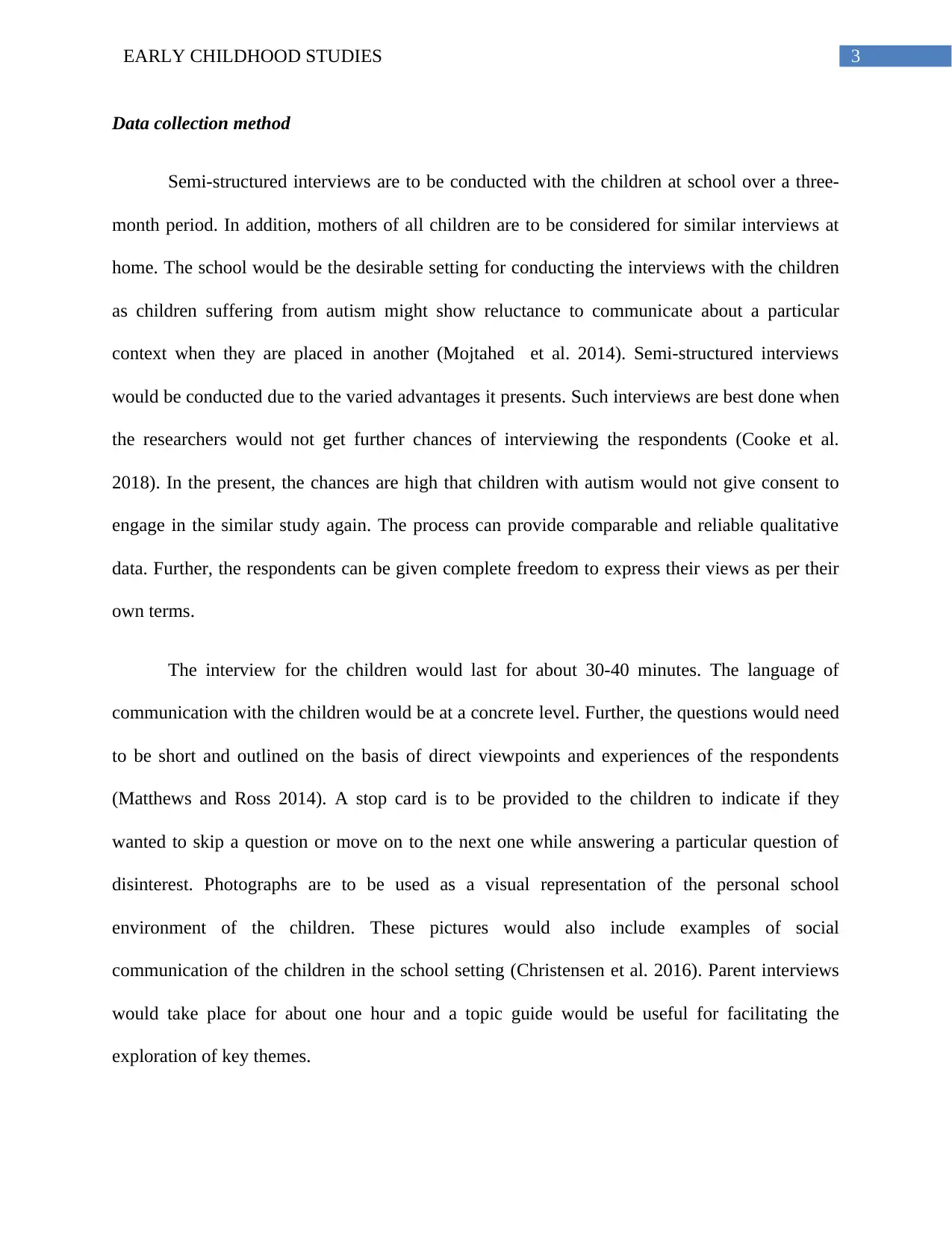
3EARLY CHILDHOOD STUDIES
Data collection method
Semi-structured interviews are to be conducted with the children at school over a three-
month period. In addition, mothers of all children are to be considered for similar interviews at
home. The school would be the desirable setting for conducting the interviews with the children
as children suffering from autism might show reluctance to communicate about a particular
context when they are placed in another (Mojtahed et al. 2014). Semi-structured interviews
would be conducted due to the varied advantages it presents. Such interviews are best done when
the researchers would not get further chances of interviewing the respondents (Cooke et al.
2018). In the present, the chances are high that children with autism would not give consent to
engage in the similar study again. The process can provide comparable and reliable qualitative
data. Further, the respondents can be given complete freedom to express their views as per their
own terms.
The interview for the children would last for about 30-40 minutes. The language of
communication with the children would be at a concrete level. Further, the questions would need
to be short and outlined on the basis of direct viewpoints and experiences of the respondents
(Matthews and Ross 2014). A stop card is to be provided to the children to indicate if they
wanted to skip a question or move on to the next one while answering a particular question of
disinterest. Photographs are to be used as a visual representation of the personal school
environment of the children. These pictures would also include examples of social
communication of the children in the school setting (Christensen et al. 2016). Parent interviews
would take place for about one hour and a topic guide would be useful for facilitating the
exploration of key themes.
Data collection method
Semi-structured interviews are to be conducted with the children at school over a three-
month period. In addition, mothers of all children are to be considered for similar interviews at
home. The school would be the desirable setting for conducting the interviews with the children
as children suffering from autism might show reluctance to communicate about a particular
context when they are placed in another (Mojtahed et al. 2014). Semi-structured interviews
would be conducted due to the varied advantages it presents. Such interviews are best done when
the researchers would not get further chances of interviewing the respondents (Cooke et al.
2018). In the present, the chances are high that children with autism would not give consent to
engage in the similar study again. The process can provide comparable and reliable qualitative
data. Further, the respondents can be given complete freedom to express their views as per their
own terms.
The interview for the children would last for about 30-40 minutes. The language of
communication with the children would be at a concrete level. Further, the questions would need
to be short and outlined on the basis of direct viewpoints and experiences of the respondents
(Matthews and Ross 2014). A stop card is to be provided to the children to indicate if they
wanted to skip a question or move on to the next one while answering a particular question of
disinterest. Photographs are to be used as a visual representation of the personal school
environment of the children. These pictures would also include examples of social
communication of the children in the school setting (Christensen et al. 2016). Parent interviews
would take place for about one hour and a topic guide would be useful for facilitating the
exploration of key themes.
Paraphrase This Document
Need a fresh take? Get an instant paraphrase of this document with our AI Paraphraser
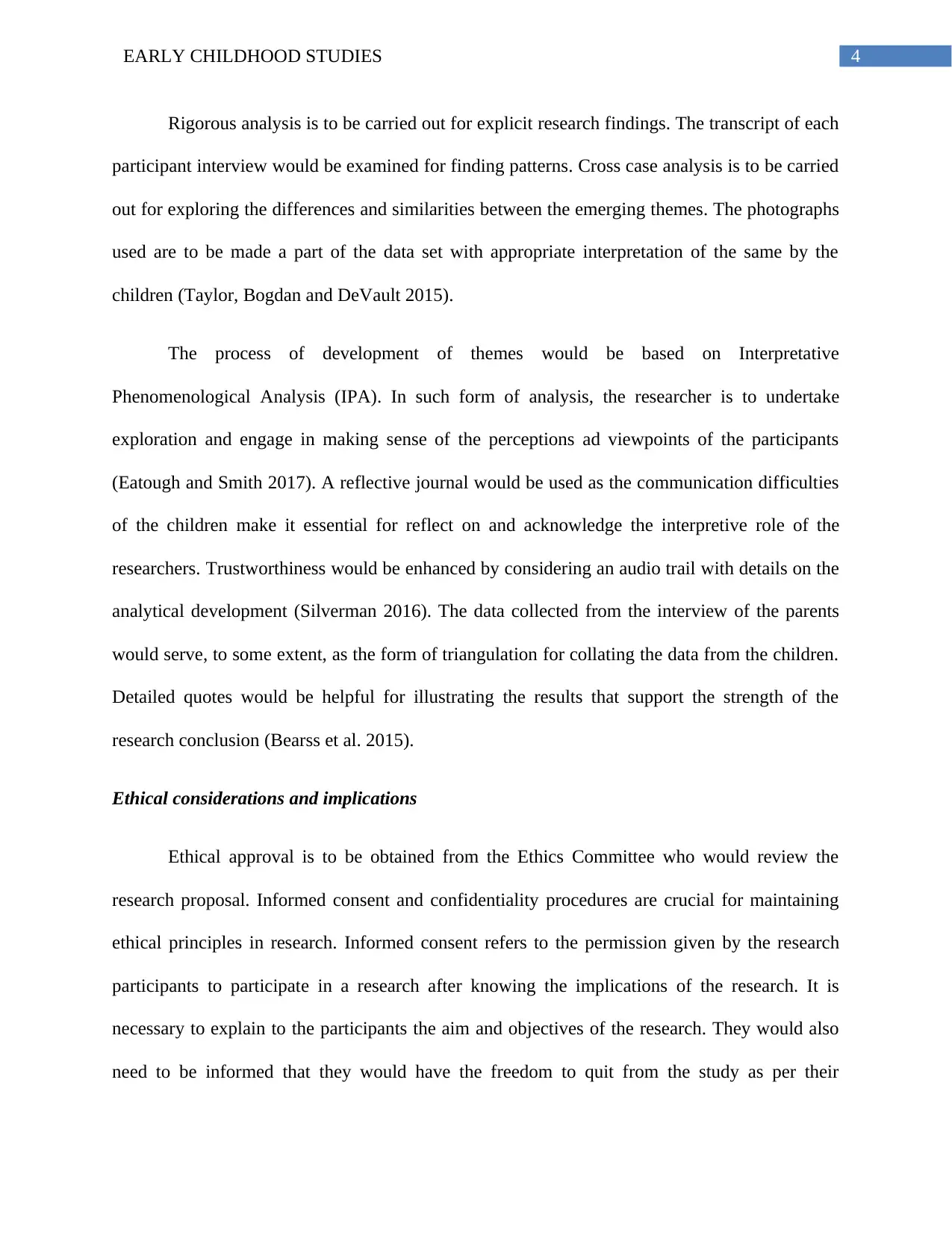
4EARLY CHILDHOOD STUDIES
Rigorous analysis is to be carried out for explicit research findings. The transcript of each
participant interview would be examined for finding patterns. Cross case analysis is to be carried
out for exploring the differences and similarities between the emerging themes. The photographs
used are to be made a part of the data set with appropriate interpretation of the same by the
children (Taylor, Bogdan and DeVault 2015).
The process of development of themes would be based on Interpretative
Phenomenological Analysis (IPA). In such form of analysis, the researcher is to undertake
exploration and engage in making sense of the perceptions ad viewpoints of the participants
(Eatough and Smith 2017). A reflective journal would be used as the communication difficulties
of the children make it essential for reflect on and acknowledge the interpretive role of the
researchers. Trustworthiness would be enhanced by considering an audio trail with details on the
analytical development (Silverman 2016). The data collected from the interview of the parents
would serve, to some extent, as the form of triangulation for collating the data from the children.
Detailed quotes would be helpful for illustrating the results that support the strength of the
research conclusion (Bearss et al. 2015).
Ethical considerations and implications
Ethical approval is to be obtained from the Ethics Committee who would review the
research proposal. Informed consent and confidentiality procedures are crucial for maintaining
ethical principles in research. Informed consent refers to the permission given by the research
participants to participate in a research after knowing the implications of the research. It is
necessary to explain to the participants the aim and objectives of the research. They would also
need to be informed that they would have the freedom to quit from the study as per their
Rigorous analysis is to be carried out for explicit research findings. The transcript of each
participant interview would be examined for finding patterns. Cross case analysis is to be carried
out for exploring the differences and similarities between the emerging themes. The photographs
used are to be made a part of the data set with appropriate interpretation of the same by the
children (Taylor, Bogdan and DeVault 2015).
The process of development of themes would be based on Interpretative
Phenomenological Analysis (IPA). In such form of analysis, the researcher is to undertake
exploration and engage in making sense of the perceptions ad viewpoints of the participants
(Eatough and Smith 2017). A reflective journal would be used as the communication difficulties
of the children make it essential for reflect on and acknowledge the interpretive role of the
researchers. Trustworthiness would be enhanced by considering an audio trail with details on the
analytical development (Silverman 2016). The data collected from the interview of the parents
would serve, to some extent, as the form of triangulation for collating the data from the children.
Detailed quotes would be helpful for illustrating the results that support the strength of the
research conclusion (Bearss et al. 2015).
Ethical considerations and implications
Ethical approval is to be obtained from the Ethics Committee who would review the
research proposal. Informed consent and confidentiality procedures are crucial for maintaining
ethical principles in research. Informed consent refers to the permission given by the research
participants to participate in a research after knowing the implications of the research. It is
necessary to explain to the participants the aim and objectives of the research. They would also
need to be informed that they would have the freedom to quit from the study as per their

5EARLY CHILDHOOD STUDIES
convenience if the need of the same is felt (Spurlin and Garven 2016). Confidentiality would be
maintained by ensuring that the research data does not have any third-party access. All
information related to the research would be stored in a save and secured manner (Bailey and
Bailey 2017).
convenience if the need of the same is felt (Spurlin and Garven 2016). Confidentiality would be
maintained by ensuring that the research data does not have any third-party access. All
information related to the research would be stored in a save and secured manner (Bailey and
Bailey 2017).
⊘ This is a preview!⊘
Do you want full access?
Subscribe today to unlock all pages.

Trusted by 1+ million students worldwide
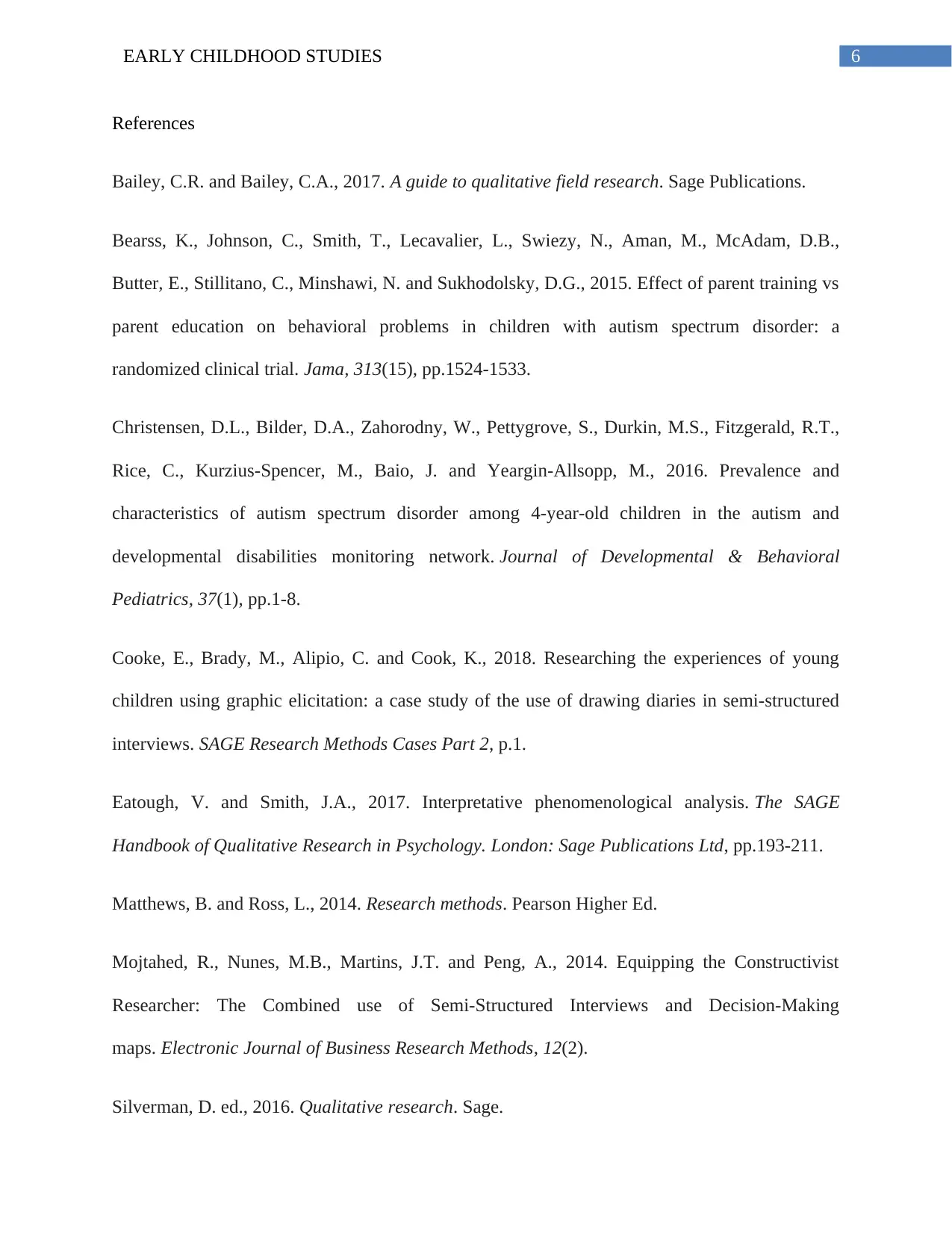
6EARLY CHILDHOOD STUDIES
References
Bailey, C.R. and Bailey, C.A., 2017. A guide to qualitative field research. Sage Publications.
Bearss, K., Johnson, C., Smith, T., Lecavalier, L., Swiezy, N., Aman, M., McAdam, D.B.,
Butter, E., Stillitano, C., Minshawi, N. and Sukhodolsky, D.G., 2015. Effect of parent training vs
parent education on behavioral problems in children with autism spectrum disorder: a
randomized clinical trial. Jama, 313(15), pp.1524-1533.
Christensen, D.L., Bilder, D.A., Zahorodny, W., Pettygrove, S., Durkin, M.S., Fitzgerald, R.T.,
Rice, C., Kurzius-Spencer, M., Baio, J. and Yeargin-Allsopp, M., 2016. Prevalence and
characteristics of autism spectrum disorder among 4-year-old children in the autism and
developmental disabilities monitoring network. Journal of Developmental & Behavioral
Pediatrics, 37(1), pp.1-8.
Cooke, E., Brady, M., Alipio, C. and Cook, K., 2018. Researching the experiences of young
children using graphic elicitation: a case study of the use of drawing diaries in semi-structured
interviews. SAGE Research Methods Cases Part 2, p.1.
Eatough, V. and Smith, J.A., 2017. Interpretative phenomenological analysis. The SAGE
Handbook of Qualitative Research in Psychology. London: Sage Publications Ltd, pp.193-211.
Matthews, B. and Ross, L., 2014. Research methods. Pearson Higher Ed.
Mojtahed, R., Nunes, M.B., Martins, J.T. and Peng, A., 2014. Equipping the Constructivist
Researcher: The Combined use of Semi-Structured Interviews and Decision-Making
maps. Electronic Journal of Business Research Methods, 12(2).
Silverman, D. ed., 2016. Qualitative research. Sage.
References
Bailey, C.R. and Bailey, C.A., 2017. A guide to qualitative field research. Sage Publications.
Bearss, K., Johnson, C., Smith, T., Lecavalier, L., Swiezy, N., Aman, M., McAdam, D.B.,
Butter, E., Stillitano, C., Minshawi, N. and Sukhodolsky, D.G., 2015. Effect of parent training vs
parent education on behavioral problems in children with autism spectrum disorder: a
randomized clinical trial. Jama, 313(15), pp.1524-1533.
Christensen, D.L., Bilder, D.A., Zahorodny, W., Pettygrove, S., Durkin, M.S., Fitzgerald, R.T.,
Rice, C., Kurzius-Spencer, M., Baio, J. and Yeargin-Allsopp, M., 2016. Prevalence and
characteristics of autism spectrum disorder among 4-year-old children in the autism and
developmental disabilities monitoring network. Journal of Developmental & Behavioral
Pediatrics, 37(1), pp.1-8.
Cooke, E., Brady, M., Alipio, C. and Cook, K., 2018. Researching the experiences of young
children using graphic elicitation: a case study of the use of drawing diaries in semi-structured
interviews. SAGE Research Methods Cases Part 2, p.1.
Eatough, V. and Smith, J.A., 2017. Interpretative phenomenological analysis. The SAGE
Handbook of Qualitative Research in Psychology. London: Sage Publications Ltd, pp.193-211.
Matthews, B. and Ross, L., 2014. Research methods. Pearson Higher Ed.
Mojtahed, R., Nunes, M.B., Martins, J.T. and Peng, A., 2014. Equipping the Constructivist
Researcher: The Combined use of Semi-Structured Interviews and Decision-Making
maps. Electronic Journal of Business Research Methods, 12(2).
Silverman, D. ed., 2016. Qualitative research. Sage.
Paraphrase This Document
Need a fresh take? Get an instant paraphrase of this document with our AI Paraphraser

7EARLY CHILDHOOD STUDIES
Smith, J.A. ed., 2015. Qualitative psychology: A practical guide to research methods. Sage.
Spurlin, D.F. and Garven, S., 2016. Unique requirements for social science human subjects
research within the United States Department of Defense. Research Ethics, 12(3), pp.158-166.
Taylor, S.J., Bogdan, R. and DeVault, M., 2015. Introduction to qualitative research methods: A
guidebook and resource. John Wiley & Sons.
Waters, J., 2016. Phenomenological research guidelines. Capilano University, pp.1-14.
Smith, J.A. ed., 2015. Qualitative psychology: A practical guide to research methods. Sage.
Spurlin, D.F. and Garven, S., 2016. Unique requirements for social science human subjects
research within the United States Department of Defense. Research Ethics, 12(3), pp.158-166.
Taylor, S.J., Bogdan, R. and DeVault, M., 2015. Introduction to qualitative research methods: A
guidebook and resource. John Wiley & Sons.
Waters, J., 2016. Phenomenological research guidelines. Capilano University, pp.1-14.
1 out of 8
Related Documents
Your All-in-One AI-Powered Toolkit for Academic Success.
+13062052269
info@desklib.com
Available 24*7 on WhatsApp / Email
![[object Object]](/_next/static/media/star-bottom.7253800d.svg)
Unlock your academic potential
Copyright © 2020–2025 A2Z Services. All Rights Reserved. Developed and managed by ZUCOL.





